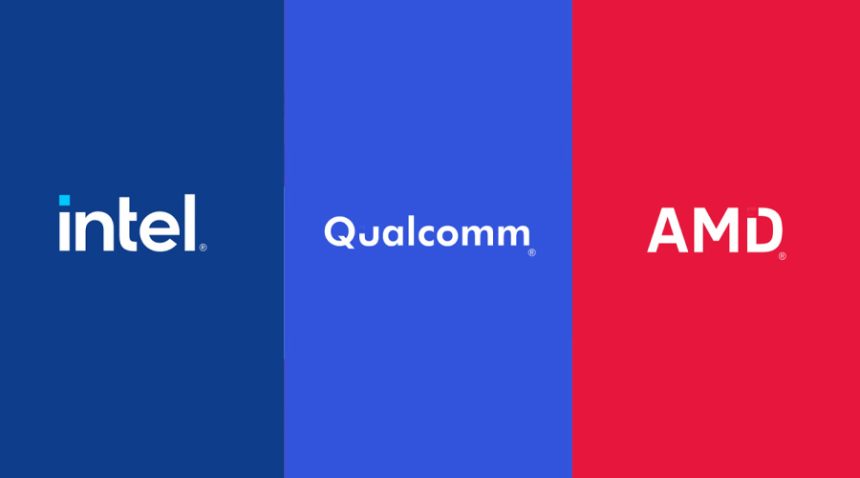Each company is striving to assert dominance through innovative technologies, strategic partnerships, and more
In 2025, the central processing unit (CPU) market is witnessing intense competition among industry giants Intel, Advanced Micro Devices (AMD), and Qualcomm. Each company is striving to assert dominance through innovative technologies, strategic partnerships, and market expansion efforts.
Intel’s Position in 2025
Intel continues to be a significant player in the CPU market, focusing on stabilizing its market share, particularly in the server segment. Despite challenges from competitors, Intel maintains that a majority of global data center workloads operate on its silicon, leveraging a robust ecosystem within the enterprise sector. The company is capitalizing on these strengths to reinforce its position in 2025.
At the Consumer Electronics Show (CES) 2025, Intel unveiled a comprehensive lineup of processors, including the Core Ultra 200V series designed for commercial thin-and-light laptops. These processors are set to feature in over 30 laptop designs from major original equipment manufacturers (OEMs) such as Lenovo, HP Inc., and Dell Technologies. Intel emphasizes advancements in battery life and artificial intelligence (AI) workload performance with this new series.
However, Intel faces significant challenges. Reports indicate a decline in market share within the data center segment, with competitors like AMD making substantial gains. Additionally, the rise of ARM-based custom chip designs by major tech companies is contributing to a shift away from Intel’s traditional x86 architecture. These developments underscore the competitive pressures Intel is encountering in 2025.
AMD’s Ascendancy
AMD has been experiencing a notable rise in market share, particularly in the server CPU sector. As of late 2024, AMD’s share in the x86 server CPU market reached 24.2%, approaching its previous peak from 2006. This growth is attributed to the success of AMD’s EPYC processors, which are recognized for their performance and energy efficiency.
In the consumer market, AMD has expanded its processor lineup with the introduction of the Ryzen AI Max series. These processors are tailored for both consumer and commercial applications, featuring models with up to 16 CPU cores and advanced AI processing capabilities. Collaborations with companies like Dell Technologies are facilitating the integration of these processors into a broader range of products, enhancing AMD’s market presence.
Despite these advancements, AMD faces challenges, including concerns about an oversupply of chips in the market. Analysts have noted that CPU shipments exceeded PC shipments by 13% in the December quarter, indicating potential inventory issues. This situation mirrors past cycles where surges in computer sales were followed by significant downturns, presenting a cautious outlook for AMD.
Qualcomm’s Strategic Moves
Qualcomm is actively pursuing expansion into markets traditionally dominated by Intel and AMD. The company has introduced the Snapdragon X series, aiming to deliver AI capabilities to more affordable PCs. With over 60 designs in production and plans to exceed 100 by 2026, Qualcomm is positioning itself as a formidable competitor in the CPU landscape.
In the Windows PC market, Qualcomm claims to hold a 10% share in the U.S. retail segment for devices priced at $800 and above, as of late 2024. This marks a significant milestone for Qualcomm, indicating progress in its efforts to penetrate the PC market.
However, projections suggest that ARM-based PCs, which include Qualcomm’s offerings, will represent only 13% of total PC shipments in 2025. This indicates that while Qualcomm is making inroads, it still faces substantial challenges in achieving widespread adoption in the PC market.
Market Dynamics and Future Outlook
The CPU market in 2025 is characterized by rapid technological advancements and shifting market shares. Intel is striving to stabilize its position amidst increasing competition, while AMD is capitalizing on its recent gains to further its market share. Qualcomm is emerging as a notable contender, leveraging its expertise in mobile processors to challenge established players in the PC and server markets.
The integration of AI capabilities into CPUs is a prominent trend, with all three companies emphasizing AI performance in their latest products. This focus reflects the growing demand for AI applications across various sectors, influencing CPU design and functionality.
As the year progresses, the competitive landscape is expected to evolve, driven by product innovations, strategic partnerships, and market responses to emerging technologies. Stakeholders will closely monitor these developments to assess the trajectories of Intel, AMD, and Qualcomm in the ongoing CPU market competition.






